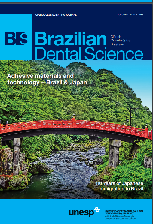Lingual mandibular bone defect: imaging features in panoramic radiograph, multislice computed tomography and magnetic resonance imaging
DOI:
https://doi.org/10.14295/bds.2018.v21i2.1557Resumo
Stafne bone defect or mandibular bone depression is defined as a bone developmental defect usually filled with soft or salivary gland tissue. Lingual posterior variant incidence is less than 0.5%. We reported a case of an 80 years old Asian female asymptomatic patient who underwent routine panoramic radiographic examination and a radiolucent area in mandible was noticed as an incidental finding, with an initial provisional diagnosis of traumatic bone cyst, aneurysmal bone cyst and lingual mandibular bone defect. The patient was then referred to multislice computed tomography and magnetic resonance imaging. Computed tomography showed a hypodense area with discontinuity in mandible base. Magnetic resonance imaging demonstrated a hyperintense image eroding mandibular body in contact with submandibular gland, which corresponded to fatty tissue and due to these imaging findings, the final diagnosis was lingual mandibular bone defect. Although the defect is a benign lesion and interventional treatment is not necessary, radiolucencies in mandible should be detailed investigated, due to their radiographic features that can resemble to other intrabony lesions. Imaging examinations can provide great defect details, especially magnetic resonance imaging, which can allow the identification of glandular tissue continuity to the mandibular defect.
Keywords
Bone cysts; Salivary glands; Magnetic resonance imaging; Computed tomography; Panoramic radiography.
Downloads
Downloads
Arquivos adicionais
Publicado
Como Citar
Edição
Seção
Licença
TRANSFERÊNCIA DE DIREITOS AUTORAIS E DECLARAÇÃO DE RESPONSABILIDADE
Toda a propriedade de direitos autorais do artigo "____________________________________________________________________" é transferido do autor(es) para a CIÊNCIA ODONTOLÓGICA BRASILEIRA, no caso do trabalho ser publicado. O artigo não foi publicado em outro lugar e não foi submetido simultaneamente para publicação em outra revista.
Vimos por meio deste, atestar que trabalho é original e não apresenta dados manipulados, fraude ou plágio. Fizemos contribuição científica significativa para o estudo e estamos cientes dos dados apresentados e de acordo com a versão final do artigo. Assumimos total responsabilidade pelos aspectos éticos do estudo.
Este texto deve ser impresso e assinado por todos os autores. A versão digitalizada deverá ser apresentada como arquivo suplementar durante o processo de submissão.




























